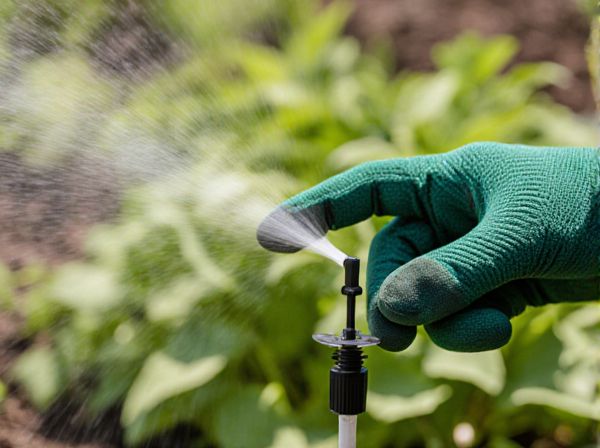
Drip Irrigation vs Wick System Illustration
Drip irrigation in hydroponics delivers a controlled and consistent flow of nutrient solution directly to plant roots, promoting efficient water usage and optimal growth rates. The wick system relies on passive capillary action to supply nutrients, making it simpler but less precise and slower in nutrient delivery. For high-yield and commercial hydroponic setups, drip irrigation offers superior control over moisture levels and nutrient distribution compared to the wick system.
Table of Comparison
| Feature | Drip Irrigation | Wick System |
|---|---|---|
| Water Delivery | Controlled, direct drip to roots | Passive, capillary action pulls water |
| Water Efficiency | High, minimal water waste | Moderate, some evaporation loss |
| Setup Complexity | Moderate, requires tubing and emitters | Simple, uses wicks and reservoir |
| Maintenance | Regular emitter cleaning needed | Low, occasional wick replacement |
| Suitability | Best for large or commercial systems | Ideal for small, low-maintenance setups |
| Cost | Higher initial investment | Low cost, budget-friendly |
| Plant Growth Control | Precise water and nutrient delivery | Less control, dependent on wick quality |
Introduction to Hydroponic Systems
Drip irrigation and wick systems are two popular hydroponic methods that optimize water and nutrient delivery to plants. Drip irrigation provides precise control by delivering nutrient solutions directly to the root zone through emitters, enhancing oxygen flow and preventing waterlogging. In contrast, wick systems rely on passive capillary action to transport nutrients, making them simpler and more affordable but less efficient for larger or high-demand crops.
Overview of Drip Irrigation in Hydroponics
Drip irrigation in hydroponics delivers water and nutrient solutions directly to the plant roots through a network of tubes and emitters, ensuring precise moisture control and minimizing waste. This system supports optimal nutrient uptake by maintaining consistent conductivity and pH levels, promoting faster growth and higher yields. Unlike wick systems, drip irrigation accommodates diverse plant types and larger-scale operations with customizable flow rates and timing controls.
Understanding the Wick System Method
The wick system method in hydroponics utilizes a passive capillary action where a wick draws nutrient solution from a reservoir to the plant roots, providing a steady supply of moisture without the need for pumps or timers. This technique is highly efficient for small-scale or low-maintenance setups, using materials like cotton or nylon to transfer water and nutrients directly to the growing medium. Compared to drip irrigation, the wick system requires less energy and infrastructure but may deliver nutrients less precisely, making it suitable for plants with moderate water demands.
Key Differences: Drip Irrigation vs Wick System
Drip irrigation delivers nutrient-rich water directly to plant roots through a controlled tubing system, optimizing water efficiency and promoting faster growth in hydroponic setups. The wick system relies on passive capillary action to draw nutrient solution into the growing medium, offering a low-maintenance and cost-effective option but with less precise moisture control. Drip irrigation suits high-demand crops requiring consistent hydration, while the wick system is ideal for smaller, low-water-use plants in beginner hydroponic systems.
Advantages of Drip Irrigation Systems
Drip irrigation systems offer precise water delivery directly to plant roots, significantly reducing water waste and promoting healthier plant growth compared to wick systems. This method enhances nutrient absorption efficiency by supplying a consistent flow of nutrient-rich water, optimizing growth rates in hydroponic setups. Automated control options available with drip irrigation allow for scalable, low-maintenance hydroponic farming with improved yield and resource management.
Benefits of Wick System Hydroponics
The Wick System in hydroponics offers a low-maintenance and cost-effective solution for small-scale or beginner growers, utilizing passive nutrient delivery without the need for pumps or electricity. This system ensures consistent moisture levels by capillary action, reducing the risk of overwatering and root rot, which promotes healthy plant growth. Its simplicity and minimal components make it ideal for indoor environments and low-energy setups.
Limitations and Challenges of Each System
Drip irrigation systems in hydroponics require precise pressure regulation and are prone to clogging from nutrient buildup, which demands regular maintenance to ensure consistent water delivery. Wick systems struggle with uneven water distribution and limited oxygen supply to the root zone, often resulting in slower plant growth and potential root rot in overly saturated conditions. Both systems face challenges in scalability and nutrient control, necessitating careful management to optimize plant health and yield.
Best Crops for Drip vs Wick Systems
Drip irrigation systems excel in supporting high-demand crops like tomatoes, cucumbers, and peppers due to precise water and nutrient delivery, promoting robust growth and higher yields. Wick systems are ideal for low-maintenance, water-efficient crops such as herbs, leafy greens, and strawberries, benefiting from passive capillary action with minimal setup. Each system optimizes growing conditions by matching water availability to crop-specific needs, enhancing hydroponic productivity.
Cost and Maintenance Comparison
Drip irrigation systems in hydroponics generally involve higher upfront costs due to pumps and emitters but offer precise water delivery and lower long-term maintenance. Wick systems are more cost-effective initially, relying on passive capillary action without electrical components, but require frequent monitoring for wick saturation and algae buildup. Overall, drip irrigation demands more complex setup but less ongoing maintenance, while wick systems are cheaper to start but can increase labor over time.
Choosing the Right System for Your Hydroponic Garden
Drip irrigation offers precise water and nutrient delivery directly to plant roots, enhancing growth efficiency and reducing waste in hydroponic gardens. Wick systems operate passively, utilizing capillary action to draw nutrient solution, making them low-maintenance but less suitable for larger or high-demand plants. Selecting the right system depends on plant type, garden scale, and resource availability, with drip irrigation preferred for commercial setups and wick systems ideal for small-scale or beginner hydroponic gardens.
Drip Irrigation vs Wick System Infographic

 gardendif.com
gardendif.com